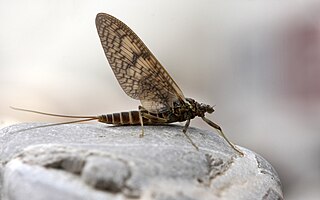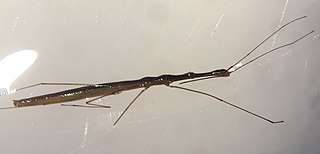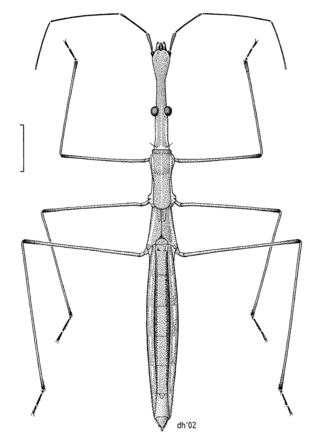
The ring-necked duck is a diving duck from North America commonly found in freshwater ponds and lakes. The scientific name is derived from Greek aithuia, an unidentified seabird mentioned by authors including Hesychius and Aristotle, and Latin collaris, "of the neck" from collum, "neck".

The tufted duck is a small diving duck with a population of close to one million birds, found in northern Eurasia. The scientific name is derived from Ancient Greek aithuia, an unidentified seabird mentioned by authors including Hesychius and Aristotle, and Latin fuligo 'soot' and gula 'throat'. It is a game bird.

The lesser yellowlegs is a medium-sized shorebird. It breeds in the boreal forest region of North America.

Buglife – The Invertebrate Conservation Trust is a UK-based nature conservation charity.

Brachytron is a monotypic genus of European dragonfly of the family Aeshnidae containing the hairy dragonfly, also known as the hairy hawker or spring hawker.

Hydrometridae is a family of semiaquatic insects, known as marsh treaders or water measurers. They have a characteristic elongated head and body which makes them resemble a yardstick for measuring the water surface.

Notonecta glauca is a species of aquatic insect, and a type of backswimmer. This species is found in large parts of Europe, North Africa, and east through Asia to Siberia and China. In much of its range it is the most common backswimmer species. It is also the most widespread and abundant of the four British backswimmers. Notonecta glauca are Hemiptera predators, that are approximately 13–16 mm in length. Females have a larger body size compared to males. These water insects swim and rest on their back and are found under the water surface. Notonecta glauca supports itself under the water surface by using their front legs and mid legs and the back end of its abdomen and rest them on the water surface; They are able to stay under the water surface by water tension, also known as the air-water interface. They use the hind legs as oars; these legs are fringed with hair and, when at rest, are extended laterally like a pair of sculls in a boat. Notonecta glauca will either wait for its prey to pass by or will swim and actively hunt its prey. When the weather is warm, usually in the late summer and autumn, they will fly between ponds. Notonecta glauca reproduce in the spring.

Pleidae, the pygmy backswimmers, is a family of aquatic insects in the order Hemiptera. There are 37 species in three genera, distributed across most of the world, except the polar regions and remote oceanic islands.

Lemna gibba, the gibbous duckweed, swollen duckweed, or fat duckweed, is a species of Lemna (duckweed). It has a simple plant body, known as a thallus, which floats on the surface of the water and measures 3–5 mm (0.12–0.20 in) in diameter. A single root hangs down into the water. Found in a wide range of still or slow-flowing water bodies, this common duckweed can also grow on mud or damp rocks.

Micronecta scholtzi, the lesser water boatman, is a species of pygmy water boatman in the family Micronectidae. It was first described by Franz Xaver Fieber in 1860. They are some 2 mm long and are common in freshwater ponds and lakes across Europe, preferring stagnant to moderately moving water. In Central Europe, the genus Micronecta is represented by five species, as follows:

Potamogeton compressus is a species of aquatic plant known by the common names grass-wrack pondweed, flatstem pondweed and eel-grass pondweed.

Rhithrogena germanica is a European species of mayfly, and is "probably the most famous of all British mayflies", because of its use in fly fishing. It is known in the British Isles as the March brown mayfly, a name which is used in the United States for a different species, Rhithrogena morrisoni. It emerges as a subimago at the end of winter, and can be distinguished from similar species by a dark spot on the femur of each leg.

Velia caprai, known as the water cricket, is a species of aquatic bug found in Europe. It grows to a length of 8.5 mm (0.33 in) and is stouter than pond skaters of the family Gerridae. It is distasteful to predatory fish, engages in kleptoparasitism, and can travel at twice its normal speed by spitting on the water surface.

Hydrometra stagnorum, the common water-measurer, is a species of aquatic bugs in the family Hydrometridae, the water measurers.

Hydrometra australis is a species of water measurer in the family Hydrometridae. It is found in the Caribbean Sea, Central America, and North America.

Hydrometra is a genus of water measurers in the family Hydrometridae. There are more than 120 described species in Hydrometra.
Hydrometra martini is a species of water measurer in the family Hydrometridae. It is found in North America.
Isogenus nubecula, also known as scarce yellow sally, is a species of stonefly belonging to the family Perlodidae. It is native to Europe.
















